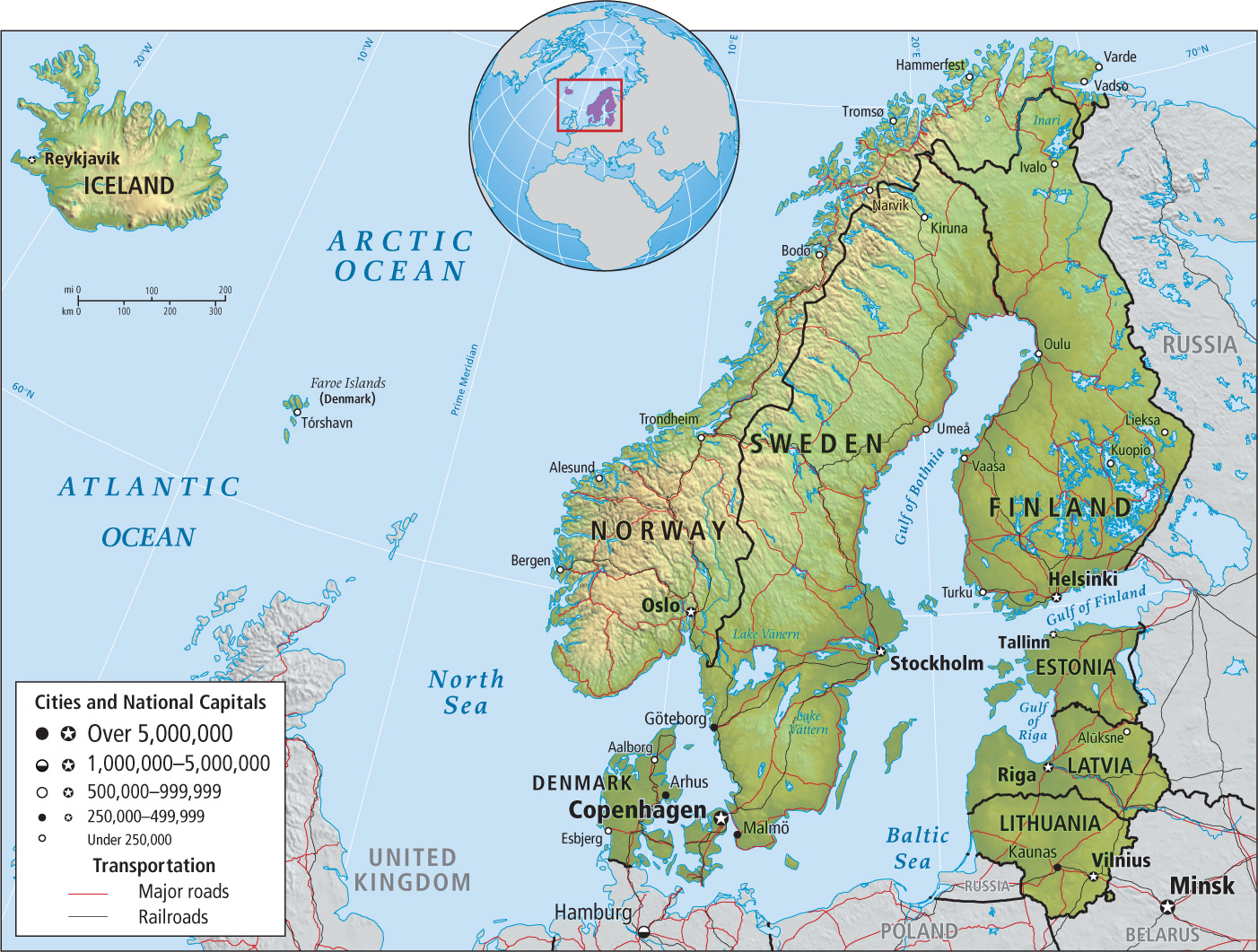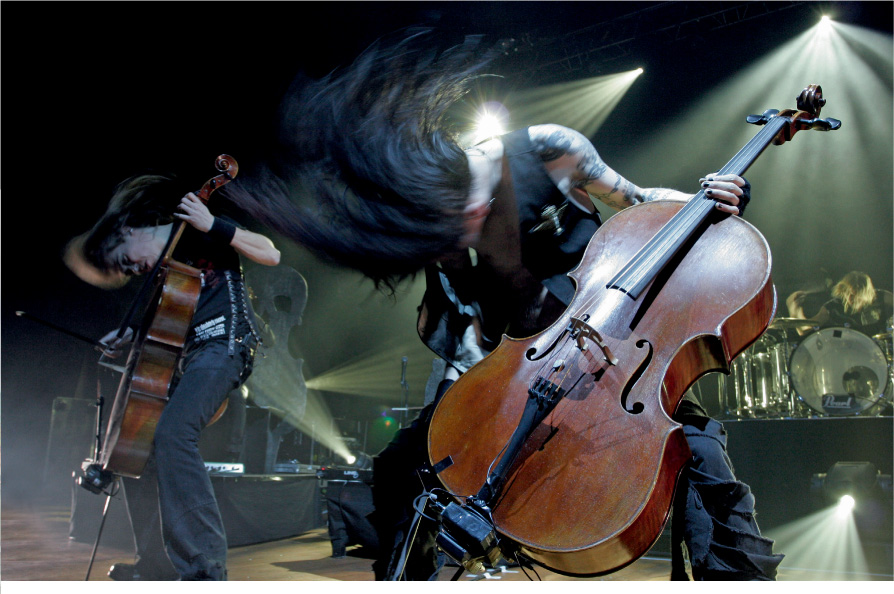North Europe
North Europe (Figure 4.33) traditionally has been defined as the countries of Scandinavia—Iceland, Denmark, Norway, Sweden, and Finland—and their various dependencies. The Faroe Islands (and Greenland) in the North Atlantic are territories of Denmark; the island of Svalbard in the Arctic Ocean is part of Norway. North Europeans are now including the three Baltic states of Estonia, Latvia, and Lithuania in their region, as we do here. All three Baltic states were part of the Soviet Union until September 1991, and these small countries have many remaining links to Russia, Belarus, and other parts of the former Soviet Union. Although their cultures are not Scandinavian, the three countries are trying to reorient their economies and societies in varying degrees to North Europe and the West.

The countries of North Europe are linked by their locations on the North Atlantic, the North Sea, and the Baltic Sea. Most citizens can drive to a coast within a few hours. The main cities of the region—Copenhagen, Oslo, Stockholm, Riga, and Helsinki—are vibrant ports that have long been centers of shipbuilding, fishing, and the transshipment and warehousing of goods. They are also home to legal and financial institutions related to maritime trade.
Scandinavia
Most people in North Europe live in the southern parts of Scandinavia (see Figure 4.19), where economic activity is concentrated. The landscapes of these warmer lowlands of southern Scandinavia are agricultural, but the economies of these countries are based on industries and services. For example, even though the small country of Denmark produces most of North Europe’s poultry, pork, dairy products, wheat, sugar beets, barley, and rye, 90 percent of the Danish economy consists of services (finance, education, design, tourism), high-tech manufacturing, construction and building trades, and fisheries. Sweden is the most industrialized nation in North Europe. The Swedes, who also like to underscore their quaint rural roots (Figure 4.34), produce most of North Europe’s transport equipment and two highly esteemed automobiles, the Saab and the Volvo (though some Volvo products are now built outside Europe and Saab is owned by a consortium based in China and Japan). IKEA, founded in Sweden, is the world’s largest furniture manufacturer. Through 332 stores in 38 countries, IKEA globally markets furniture and housewares famed for their affordability and spare, elegant design. IKEA is a major consumer of woods logged in the world’s tropical zones (see Figure 10.8); China is the largest producer of IKEA products. Helsinki, Finland, is home to some of the world’s most successful information technology companies, such as Tieto, Nokia, and Novo Group.

The northern part of Sweden and almost all of Norway are covered by mountainous terrain, while Finland is a low-lying land dotted with glacial lakes, much like northern Canada. Sweden and Finland contain most of Europe’s remaining forests. These well-managed forests produce timber and wood pulp. Norway, which has less usable forestland, had been considered poorly endowed with natural resources compared with the rest of Scandinavia, but the discovery of gas and oil under the North Sea in the 1960s and 1970s has been a windfall to the country. The exploitation of these resources dwarfs all other sectors of Norway’s economy. Norway is able to supply its own energy needs through hydropower, and it exports oil and gas to the European Union. It is now one of Europe’s wealthiest countries and ranks highest in the world in human well-being. In anticipation of the North Sea oil running out, Norway has invested a large proportion of its oil profits for use by future generations.
The fishing grounds of the North Sea, the North Atlantic, and the southern Arctic Ocean are also an important resource for the countries of North Europe (as well as for several other countries on the Atlantic). In recent decades, however, overfishing has severely reduced fish stocks. Rights of access to the fishing grounds remain a cause of dispute, but in 1994, the European Union created a joint 200-mile (320-kilometer) coastal exclusive economic zone (EEZ) that ensures equal access and sets fishing quotas for member states. In January 2001, in order to give North Sea fish populations a chance to rebound, EU members plus Norway and Iceland agreed to an annual 3-month hiatus in cod fishing and in the taking of all juvenile fish that were used to feed salmon in commercial farms. By 2006, however, it was clear that these short respites from fishing had not increased the cod population; a hiatus of as long as 12 years was called for over a much bigger area of the North Sea. A small recovery in 2009 gave cause for hope, but current thinking is that global warming may account for some of the drastic slump in cod catches.
Two important characteristics distinguish the Scandinavian countries from other European nations: their strong social welfare systems and the extent to which they have equal levels of participation and well-being for men and women (see Figure 4.27C).
Sweden’s cradle-to-grave social welfare system provides stability and a safety net for every one of the country’s 9.4 million people. This system is founded on three values. First is the idea of security: that all people are entitled to a safe, secure, and predictable way of life with as little discomfort as possible. This concern extends to interior design in subsidized housing, which is modern, elegant, and practical. Second, the appropriate life is ordered, self-sufficient, and quiet, not marred by efforts to stand out above others. Third, when the first two concepts are practiced properly, the ideal society, folkhem (“people’s home”), is achieved. These three values help explain why Swedes are willing to pay for a social welfare system that provides child care, parental leave, health care, sick leave, elder care, housing subsidies, and other benefits. As of 2012, the system amounted to about half of the government’s annual budget and was not confined only to citizens; immigrants were also covered, though some Swedes have expressed their dissatisfaction about this.
For all their emphasis on an orderly peaceful life that is fair for all, Scandinavians are noted for occasional outbursts of exuberant enthusiasm for over-the-top adventures. One such example is the Scandinavian love for heavy metal music. Figure 4.35 shows the Finnish band Apocalyptica, known for its inventive orchestral embellishments of metal music.  100. SWEDEN HOME TO MORE IRAQI REFUGEES THAN OTHER EUROPEAN COUNTRIES
100. SWEDEN HOME TO MORE IRAQI REFUGEES THAN OTHER EUROPEAN COUNTRIES

The Baltic States
The three small Baltic states of Estonia, Latvia, and Lithuania are situated together on the east coast of the Baltic Sea. Culturally, these countries are distinct from one another, with different languages, myths, histories, and music. After World War II, all three were forced to become Soviet republics. When the Soviet Union collapsed in 1991, they regained their independence. Despite their recent connection to Russia, their cultural ties traditionally lean toward West and North Europe. Ethnic Estonians, who make up 60 percent of the people in Estonia, are nominally Protestant, with strong links to Finland; they view themselves as Scandinavians. Ethnic Latvians, who are just 50 percent of the population of Latvia, are mostly Lutheran; they see themselves as part of the old German maritime trade tradition. Lithuanians are primarily Roman Catholic and also see themselves as a part of western Europe.
Populations in all three countries are decreasing and aging because birth rates are very low and young people now have the option to migrate to North and West Europe. Ethnic Russians, who today make up about a third of the population in both Estonia and Latvia, are having more children than the indigenous populations are. They could become the dominant culture group within a few decades—a crucial development if these ethnic Russians continue to cultivate strong political ties with Russia. Ironically, although the Russian minority was established in the Baltic states to maintain the influence of the Soviet Union, under EU rules, their rights as minorities had to be guaranteed before the Baltic countries could join the European Union. All three are now EU members.
Of all the countries of North Europe, the Baltic states have the most precarious economic outlook. Under Soviet rule, the Russians expropriated their agricultural and industrial facilities and used them primarily for Russia’s benefit. Until 1991, ninety percent of the Baltic states’ trade was with other Soviet republics. Since then, Estonia has undertaken the most radical economic change, moving toward a market economy and increasing its trade with the West. Estonia is the only one of the three to have had real economic growth, and its accomplishments have attracted foreign aid and private investors. Heavily industrialized Latvia and Lithuania now trade more with the U.K., Germany, and the West than with Russia. They have had to increase their standards of quality, but many of their factories are out of date and still pollute heavily.
exclave a portion of a country that is separated from the main part
The Baltic states see national security as their major problem because their strategic position along the Baltic Sea has long been coveted by Russia, which has few easy outlets to the world’s oceans. In this regard, the status of the Russian exclave of Kaliningrad is crucial. Kaliningrad is called an exclave because, although it is an actual part of Russia, it lies far from the main part of Russia. Kaliningrad is situated along the Baltic Sea, between two EU states, Lithuania and Poland (see Figures 4.1 and 4.36). The Russian Baltic fleet is headquartered in Kaliningrad, which has a relatively ice-free port (see the discussion in Chapter 5). Russia’s strategic interest in Lithuania is unlikely to diminish, and Lithuania fears that political instability in Russia could result in Russia reinvading Lithuania. The countries of western Europe, unwilling to commit to supporting Lithuania militarily, hope to resolve differences with the Russians without antagonizing them.
THINGS TO REMEMBER
 Five of the northern Europe countries rank very high on the human development index; in fact, they are in the top 16 in the world and all have the most complete, albeit expensive, social welfare systems in Europe (and probably the world).
Five of the northern Europe countries rank very high on the human development index; in fact, they are in the top 16 in the world and all have the most complete, albeit expensive, social welfare systems in Europe (and probably the world). The three Baltic states all rank in the high range of human development but are struggling to improve their economic competitiveness. All three see security as a major issue because of Russia’s power and its desire for access to the Baltic Sea.
The three Baltic states all rank in the high range of human development but are struggling to improve their economic competitiveness. All three see security as a major issue because of Russia’s power and its desire for access to the Baltic Sea.